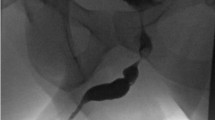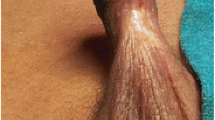Abstract
Purpose
To review our experience with infants undergoing distal hypospadias repair without a postoperative stent to determine if an unacceptable complication rate might justify its use.
Methods
Children <1 year of age who underwent distal hypospadias repair by a single surgeon were identified through a prospectively maintained database. The use of a postoperative urethral stent was recorded for each case. Demographics, meatus position, operative technique and complications were also recorded. Patients older than 1 year or with hypospadias proximal to a subcoronal position were excluded.
Results
Eighty-nine patients without a stent were identified in addition to 21 patients who had a stent for a minimum of 3 days. At 3 months follow-up, 4/89 (4.49 %) patients in the stentless group required circumcision revision. 1 patient experienced urinary retention. 1/21 (4.76 %) patients with a postoperative stent required reoperation for meatal stenosis.
Conclusions
The complication rate for infants undergoing distal hypospadias repair is low, does not appear to be significantly increased by forgoing a postoperative urethral stent. Avoiding a stent likely reduces a variety of associated adverse events and needs for short-term follow-up.
Similar content being viewed by others
References
Ritch CR, Murphy AM, Woldu SL, Reiley EA, Hensle TW (2010) Overnight urethral stenting after tubularized incised plate urethroplasty. Pediatr Surg Int 26:639–642
el-Kassaby AW, Al-Kandari AM, Elzayat T, Shokeir AA (2008) Modified tubularized incised plate urethroplasty for hypospadias repair: long-term results of 764 patients. Urology 71(4):611–615
Baccala AA Jr, Ross J, Detore N, Kay R (2005) Modified tubularized incised plate urethroplasty (Snodgrass) procedure for hypospadias repair. Urology 66(6):1305–1306
Lorenz C, Schmedding A, Leutner A, Kolb H (2004) Prolonged stenting does not prevent obstruction after TIP repair when the glans was deeply incised. Eur J Pediatr Surg 14(5):322–327
Steckler RE, Zaontz MA (1997) Stent-free Thiersch–Duplay hypospadias repair with the Snodgrass modification. J Urol 158:1178–1180
Hakim S, Merguerian PA, Rabinowitz R, Shortliff LD, McKenna PH (1996) Outcome analysis of the modified Mathieu hypospadias repair: comparison of stented and unstented repairs. J Urol 156:836–838
Turial S, Enders J, Engel V, Schier F (2011) Stent-free tubularized incised plate (TIP) repair of distal and mid-shaft hypospadias irrespective of age. Eur J Pediatr Surg 21:168–170
Leclair MD, Camby C, Battisti S, Renaud G, Plattner V, Heloury Y (2004) Unstented tubularized incised plate urethroplasty combined with foreskin reconstruction for distal hypospadias. Eur Urol 46(4):526–530
Snodgrass WT, Nguyen MT (2002) Current technique of tubularized, incised plate hypospadias repair. Urology 60:157–162
Atala A (2002) Urethral mobilization and advancement for mid shaft to distal hypospadias. J Urol 168(4 Pt 2):1738–1741 (discussion 1741)
Duckett JW (1981) MAGPI (meatoplasty and glanuloplasty): a procedure for subcoronal hypospadias. Urol Clin North Am 8(3):513–519
Dindo D, Demartines N, Clavien PA (2004) Classification of surgical complications: a new proposal with evaluation in a cohort of 6336 patients and results of a survey. Ann Surg 240(2):205–213
Mustafa NA, Lope RJ, Cheah FC (2006) Spontaneous knot formation impeding the removal of a silicone urethral catheter. Arch Dis Child Fetal Neonatal Ed 91(4):F287
Snodgrass WT (1994) Tubularized, incised plate urethroplasty for distal hypospadias. J Urol 151(2):464–465
El-Sherbiny MT (2003) Tubularized incised plate repair of distal hypospadias in toilet-trained children: should a stent be left? BJU Int 92:1003–1005
Hafez AT, Herz D, Bägli D, Smith CR, McLorie G, Khoury AE (2003) Healing of unstented tubularized incised plate urethroplasty: an experimental study in a rabbit model. BJU Int 91:84–88
Bleustein CB, Esposito MP, Soslow RA, Felsen D, Poppas DP (2001) Mechanism of healing following the Snodgrass repair. J Urol 165(1):277–279
McLorie G, Joyner B, Herz D, McCallum J, Bagli D, Merguerian P, Khoury A (2001) A prospective randomized clinical trial to evaluate methods of postoperative care of hypospadias. J Urol 165(5):1669–1672
Buson H, Smiley D, Reinberg Y, Gonzalez R (1994) Distal hypospadias repair without stents: is it better? J Urol 151(4):1059–1060
Author information
Authors and Affiliations
Corresponding author
Rights and permissions
About this article
Cite this article
Chalmers, D.J., Siparsky, G.L., Wiedel, C.A. et al. Distal hypospadias repair in infants without a postoperative stent. Pediatr Surg Int 31, 287–290 (2015). https://doi.org/10.1007/s00383-014-3647-y
Accepted:
Published:
Issue Date:
DOI: https://doi.org/10.1007/s00383-014-3647-y




